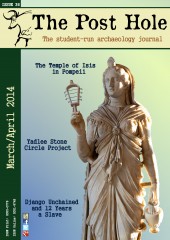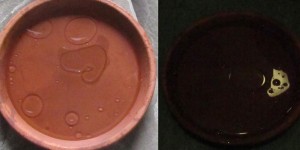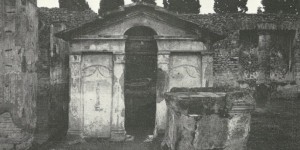This paper looks at arguably the most ancient documented form of fortune-telling: Old Babylonian oil divination. The principle aim is to raise awareness of a much under-studied element in the ancient Mesopotamian textual record, giving some suggestions regarding its social function along the way. Additionally, the investigation provides a short case study demonstrating how practical work can be used to provide an insight into a psychological framework which neither archaeology, nor textual records, can adequately reveal. This in turn has important applications for outreach activities, designed to raise wider awareness of the ancient world among the modern public, as the reconstructive methodologies in question can extend their appeal far beyond conventional academic circles.
Oil divination in ancient Mesopotamia was already well established by the Old Babylonian period in the early 2nd millennium BCE, but the great complexity of the ‘omen corpora’ relating to it at this time, strongly implies that it had already been developing over many years. An origin in the 3rd millennium BCE is therefore not improbable, which would coincide with the rapid development of urbanism, social stratification and non-utilitarian ritualistic occupations which are characteristic of Mesopotamia in this period (van de Mieroop 2007).
In particular, the development of the ‘cuneiform’ writing system allowed for the recording of complicated procedures alongside purely administrative records, and this is evident in the oil omens. An emerging scribal class, best documented at sites like Ur and Nippur, but present throughout Mesopotamia (Black et al. 2006), was therefore likely to be intrinsically connected with the spread of oil divination as a methodical and academic pursuit.
Limitations in the textual descriptions available mean that the exact procedure of oil divination is impossible to reconstruct, but it was most likely a two-stage process (Pettinato 1966). First, a bowl of water had oil poured onto it, producing an initial oil pattern visible on the water surface. Next, more water was added, creating a new pattern. Both the primary and secondary patterns were significant, with one compendium of omens dealing with “pouring oil on water” and another concerned with “pouring water on oil” (Pettinato 1966).
Each omen followed a rigid structure, which was a result clause consisting of a protasis and apodosis, the former stating the characteristics of the visible pattern and the latter explaining what this heralded. Key elements in the oil-water patterns apparently included the number of bubbles, their size, colour, location in the bowl and any movements in relation to cardinal compass points. Thus, a typical example might be “(if) one throws water onto oil and it disperses evenly (protasis), the house of the man will be scattered (apodosis)” (text 1 in Pettinato 1966, 33).
Needless to say, on what basis protases and apodoses were consequentially matched up is deeply unclear, especially as a number of crucial variables such as bowl size, light intensity and type of oil used, cannot be determined with any confidence. Nonetheless, the information which the textual corpus did provide, proved sufficient to at least construct a rough outline of the process, in the hope that practical work could supply some additional answers.
The experiments were carried out in two stages, as stipulated by the omens themselves. First oil was added to water, and then more water was poured over this oil. Although the method certainly cannot claim to accurately represent the original technique, it was a highly useful way of engaging with the materiality of rapidly changing liquid patterns in a limited space. Notably, the importance of the size, number and colour of bubbles, alongside their positions and movements, were all confirmed. Similarly, the experiments highlighted the importance of light intensity, as patterns appeared very different in light and dark conditions (Figure 1).
However, perhaps the most important inference was the great degree of subjectivity inherent in the method, there always being multiple ways of describing any oil pattern and therefore ample scope for fitting a single result to several omens. This would suggest that individual judgement and arbitrary interpretation would have been crucial, with the judgement of the diviner determining the outcome of the divination far more than the oil pattern itself.
This last conclusion has especially interesting implications. With oil divination results ultimately being seen as divine verdicts, a particular divinatory outcome could therefore justify a specific course of action. In the highly charged political climate of ancient Mesopotamia, this could have crucial significance as rulers or other decision-makers could transfer responsibility for their own actions onto culturally postulated superhuman agents (Koch 2010). This would essentially mean that they were just carrying out the wishes of gods in accordance with omen outcomes, and had no agency of their own. This has been shown to be the case in liver extispicies carried out in the Neo-Assyrian period of the early 1st millennium BCE (Radner 2009, 2011), but the ambiguous nature of many oil omens suggests that this early 2nd millennium BCE method could have had a similar function.
It is certainly easy to envisage unclear oil patterns being interpreted in a way which matched the preferred political decisions of rulers. With a highly exclusive literate class of diviners seen to possess esoteric knowledge, their interpretation would be seen as the will of the gods, rather than just the arbitrary will of the ruler, which merely happened to coincide with the decision of divine authority. If this ‘theory of mind mechanism’ works for agency transfers in Neo-Assyria (Koch 2010), there is little reason to suggest that the Old Babylonian period was any different.
However, there is still one further unanswered question: even though one can suggest a compelling socio-political function for the divinations, as shown earlier, it is far more difficult to understand the basis of linkage between protases and apodoses. Why does an even dispersal of water on the oil surface mean that the house of a man will be scattered, as in the earlier example? On the basis of the experiments, it may be productive to employ a scaled-down phenomenological approach, studying the omens through an analysis of the direct sensory experience, and the power of subconscious mental triggers.
Thus, it may be that the interaction between oil and water was sometimes seen as a complex metaphor for the relationship between man and his life. For example, in “(if) the oil develops horns when one pours water, the wife of the man will go away” (text 1 in Pettinato 1966, 16), the concept of a ‘horned husband’ quite possibly existing in Mesopotamia makes it tempting to assume that this omen may therefore be down to more than just coincidence. Likewise, in “(if) the oil sinks and rises up when one pours water, the man will come forth from difficulty” (text 1 in Pettinato 1966, 36), there is perhaps a reflection of the man sinking under the burden of life but then regaining control, and this is supported by a contrasting omen saying that “(if) the oil sinks and stays at the bottom when one pours water, the man will die” (text 1 in Pettinato 1966, 35).
Such metaphorical linkages, perhaps connected to phenomenological interpretations of the oil-water ‘landscape’ (Tilley 1994), are therefore on the whole, likely to be present, but they cannot explain everything. Indeed, the majority of omens remain entirely mysterious – a case in point may be “if one throws oil onto water and it forms three bubbles, the sun god will desire an offering” (text 1 in Pettinato 1966, 6); here, establishing a metaphorical or phenomenological connection between three bubbles and the sun god is very problematic indeed. This analysis thus goes to show that there is still much to clarify, providing ample scope for further research.
Away from the purely academic side, the project’s important public outreach dimension deserves mention. The reconstructive element at the heart of the research provides a strong initial platform for archaeology-based events for the general public, and the project was instrumental in the highly successful bid to host an ‘Assyriology Awareness Day’ at the 2013 Cambridge Festival of Ideas.
With funding running ever-tighter and university projects increasingly needing to prove their worth to public and politicians alike, the appeal of the reconstructive element certainly cannot be underestimated in efforts to prove that Assyriology deserves to retain a place in the world. At a time when the often violent events of the Arab Spring have incapacitated many other projects associated with Ancient Near Eastern history, this certainly comes as a welcome boost.
To conclude, the task of understanding and recreating Old Babylonian oil divination is far from complete, but valuable steps in the right direction have been made. By making comparisons with later divinatory techniques such as Neo-Assyrian extispicy, it has proved possible to suggest a prominent socio-political function for this older method, based on the transfer of agency from genuine rulers to culturally postulated deities. Furthermore, the experimental side has sparked interesting questions regarding possible metaphorical and micro-phenomenological undertones influencing the protasis-apodosis linkage chains occurring throughout the corpus.
The fact that this valuable research has been undertaken whilst simultaneously yielding a viable public outreach project, is another formidable asset. Undoubtedly, many questions remain unsolved and gaps in the textual record mean that this is likely to remain the case, but at least the foundations for a more detailed investigation into oil divination and its wider place in Mesopotamian culture have been laid.
The author would like to thank Dr Eleanor Robson and Dr Martin Worthington of Cambridge University for providing valuable academic advice. Special thanks is also due to Christoph Schmidhuber, also of Cambridge University, who helped carry out the experiments and who proposed a valuable framework for future research in this field. Needless to say, the author takes all responsibility for any shortcomings, simplifications or omissions in this paper.
Bibliography
- Black, J., Cunningham, G., Robson, E., Zólyomi, G. (2006) The Literature of Ancient Sumer. Oxford: Oxford University Press.
- Koch, U. (2010) ‘Three Strikes and you’re out! A View on the Cognitive Theory and the First Millennium Extispicy Ritual’, in A. Annus (ed.) Divination and Interpretation of Signs in the Ancient World. Chicago: Oriental Institute Publications, 43-59.
- Pettinato, G. (1966) Die Ölwahrsagung bie den Babyloniern: Band I & II. Rome: Eisenbrauns.
- Radner, K. (2009) ‘The Assyrian King and his Scholars: The Syro-Anatolian and the Egyptian Schools’, in M. Luuko, S. Svärd and R. Mattila (eds.) Of Gods, Trees, Kings and Scholars: Neo-Assyrian and Related Studies in Honour of Simo Parpola. Helsinki: Helsinki University Press, 221-237.
- Radner, K. (2011) ‘Royal Decision-Making: Kings, Magnates and Scholars’, in K. Radner and E. Robson (eds.) The Oxford Handbook of Cuneiform Culture. Oxford: Oxford University Press, 358-375.
- Tilley, C. (1994) A Phenomenology of Landscape: Places, Paths and Monuments. Oxford: Berg Publishers.
- Van de Mieroop, M. (2007) A History of the Ancient Near East. Oxford: Blackwell.









